Dump | AZ 104: Microsoft Azure Administrator miễn phí
Introductory Info Case study -
This is a case study. Case studies are not timed separately. You can use as much exam time as you would like to complete each case. However, there may be additional case studies and sections on this exam. You must manage your time to ensure that you are able to complete all questions included on this exam in the time provided.
To answer the questions included in a case study, you will need to reference information that is provided in the case study. Case studies might contain exhibits and other resources that provide more information about the scenario that is described in the case study. Each question is independent of the other questions in this case study.
At the end of this case study, a review screen will appear. This screen allows you to review your answers and to make changes before you move to the next section of the exam. After you begin a new section, you cannot return to this section.
To start the case study -
To display the first question in this case study, click the Next button. Use the buttons in the left pane to explore the content of the case study before you answer the questions. Clicking these buttons displays information such as business requirements, existing environment, and problem statements. If the case study has an All Information tab, note that the information displayed is identical to the information displayed on the subsequent tabs. When you are ready to answer a question, click the Question button to return to the question.
Overview -
Contoso, Ltd. is a manufacturing company that has offices worldwide. Contoso works with partner organizations to bring products to market.
Contoso products are manufactured by using blueprint files that the company authors and maintains.
Existing Environment -
Currently, Contoso uses multiple types of servers for business operations, including the following:
File servers
Domain controllers
Microsoft SQL Server servers
Your network contains an Active Directory forest named contoso.com. All servers and client computers are joined to Active Directory.
You have a public-facing application named App1. App1 is comprised of the following three tiers:
A SQL database
A web front end
A processing middle tier -
Each tier is comprised of five virtual machines. Users access the web front end by using HTTPS only.
Requirements -
Planned Changes -
Contoso plans to implement the following changes to the infrastructure:
Move all the tiers of App1 to Azure.
Move the existing product blueprint files to Azure Blob storage.
Create a hybrid directory to support an upcoming Microsoft 365 migration project.
Technical Requirements -
Contoso must meet the following technical requirements:
Move all the virtual machines for App1 to Azure.
Minimize the number of open ports between the App1 tiers.
Ensure that all the virtual machines for App1 are protected by backups.
Copy the blueprint files to Azure over the Internet.
Ensure that the blueprint files are stored in the archive storage tier.
Ensure that partner access to the blueprint files is secured and temporary.
Prevent user passwords or hashes of passwords from being stored in Azure.
Use unmanaged standard storage for the hard disks of the virtual machines.
Ensure that when users join devices to Azure Active Directory (Azure AD), the users use a mobile phone to verify their identity.
Minimize administrative effort whenever possible.
User Requirements -
Contoso identifies the following requirements for users:
Ensure that only users who are part of a group named Pilot can join devices to Azure AD.
Designate a new user named Admin1 as the service admin for the Azure subscription.
Admin1 must receive email alerts regarding service outages.
Ensure that a new user named User3 can create network objects for the Azure subscription. Question You need to implement a backup solution for App1 after the application is moved.
What should you create first?
- A. a recovery plan
- B. an Azure Backup Server
- C. a backup policy
- D. a Recovery Services vault
Introductory Info Case study -
This is a case study. Case studies are not timed separately. You can use as much exam time as you would like to complete each case. However, there may be additional case studies and sections on this exam. You must manage your time to ensure that you are able to complete all questions included on this exam in the time provided.
To answer the questions included in a case study, you will need to reference information that is provided in the case study. Case studies might contain exhibits and other resources that provide more information about the scenario that is described in the case study. Each question is independent of the other questions in this case study.
At the end of this case study, a review screen will appear. This screen allows you to review your answers and to make changes before you move to the next section of the exam. After you begin a new section, you cannot return to this section.
To start the case study -
To display the first question in this case study, click the Next button. Use the buttons in the left pane to explore the content of the case study before you answer the questions. Clicking these buttons displays information such as business requirements, existing environment, and problem statements. If the case study has an All Information tab, note that the information displayed is identical to the information displayed on the subsequent tabs. When you are ready to answer a question, click the Question button to return to the question.
Overview -
Contoso, Ltd. is a manufacturing company that has offices worldwide. Contoso works with partner organizations to bring products to market.
Contoso products are manufactured by using blueprint files that the company authors and maintains.
Existing Environment -
Currently, Contoso uses multiple types of servers for business operations, including the following:
File servers
Domain controllers
Microsoft SQL Server servers
Your network contains an Active Directory forest named contoso.com. All servers and client computers are joined to Active Directory.
You have a public-facing application named App1. App1 is comprised of the following three tiers:
A SQL database
A web front end
A processing middle tier -
Each tier is comprised of five virtual machines. Users access the web front end by using HTTPS only.
Requirements -
Planned Changes -
Contoso plans to implement the following changes to the infrastructure:
Move all the tiers of App1 to Azure.
Move the existing product blueprint files to Azure Blob storage.
Create a hybrid directory to support an upcoming Microsoft 365 migration project.
Technical Requirements -
Contoso must meet the following technical requirements:
Move all the virtual machines for App1 to Azure.
Minimize the number of open ports between the App1 tiers.
Ensure that all the virtual machines for App1 are protected by backups.
Copy the blueprint files to Azure over the Internet.
Ensure that the blueprint files are stored in the archive storage tier.
Ensure that partner access to the blueprint files is secured and temporary.
Prevent user passwords or hashes of passwords from being stored in Azure.
Use unmanaged standard storage for the hard disks of the virtual machines.
Ensure that when users join devices to Azure Active Directory (Azure AD), the users use a mobile phone to verify their identity.
Minimize administrative effort whenever possible.
User Requirements -
Contoso identifies the following requirements for users:
Ensure that only users who are part of a group named Pilot can join devices to Azure AD.
Designate a new user named Admin1 as the service admin for the Azure subscription.
Admin1 must receive email alerts regarding service outages.
Ensure that a new user named User3 can create network objects for the Azure subscription. Question You need to move the blueprint files to Azure.
What should you do?
- A. Generate an access key. Map a drive, and then copy the files by using File Explorer.
- B. Use Azure Storage Explorer to copy the files.
- C. Use the Azure Import/Export service.
- D. Generate a shared access signature (SAS). Map a drive, and then copy the files by using File Explorer.
Introductory Info Case study -
This is a case study. Case studies are not timed separately. You can use as much exam time as you would like to complete each case. However, there may be additional case studies and sections on this exam. You must manage your time to ensure that you are able to complete all questions included on this exam in the time provided.
To answer the questions included in a case study, you will need to reference information that is provided in the case study. Case studies might contain exhibits and other resources that provide more information about the scenario that is described in the case study. Each question is independent of the other questions in this case study.
At the end of this case study, a review screen will appear. This screen allows you to review your answers and to make changes before you move to the next section of the exam. After you begin a new section, you cannot return to this section.
To start the case study -
To display the first question in this case study, click the Next button. Use the buttons in the left pane to explore the content of the case study before you answer the questions. Clicking these buttons displays information such as business requirements, existing environment, and problem statements. If the case study has an All Information tab, note that the information displayed is identical to the information displayed on the subsequent tabs. When you are ready to answer a question, click the Question button to return to the question.
Overview -
Contoso, Ltd. is a manufacturing company that has offices worldwide. Contoso works with partner organizations to bring products to market.
Contoso products are manufactured by using blueprint files that the company authors and maintains.
Existing Environment -
Currently, Contoso uses multiple types of servers for business operations, including the following:
File servers
Domain controllers
Microsoft SQL Server servers
Your network contains an Active Directory forest named contoso.com. All servers and client computers are joined to Active Directory.
You have a public-facing application named App1. App1 is comprised of the following three tiers:
A SQL database
A web front end
A processing middle tier -
Each tier is comprised of five virtual machines. Users access the web front end by using HTTPS only.
Requirements -
Planned Changes -
Contoso plans to implement the following changes to the infrastructure:
Move all the tiers of App1 to Azure.
Move the existing product blueprint files to Azure Blob storage.
Create a hybrid directory to support an upcoming Microsoft 365 migration project.
Technical Requirements -
Contoso must meet the following technical requirements:
Move all the virtual machines for App1 to Azure.
Minimize the number of open ports between the App1 tiers.
Ensure that all the virtual machines for App1 are protected by backups.
Copy the blueprint files to Azure over the Internet.
Ensure that the blueprint files are stored in the archive storage tier.
Ensure that partner access to the blueprint files is secured and temporary.
Prevent user passwords or hashes of passwords from being stored in Azure.
Use unmanaged standard storage for the hard disks of the virtual machines.
Ensure that when users join devices to Azure Active Directory (Azure AD), the users use a mobile phone to verify their identity.
Minimize administrative effort whenever possible.
User Requirements -
Contoso identifies the following requirements for users:
Ensure that only users who are part of a group named Pilot can join devices to Azure AD.
Designate a new user named Admin1 as the service admin for the Azure subscription.
Admin1 must receive email alerts regarding service outages.
Ensure that a new user named User3 can create network objects for the Azure subscription. Question HOTSPOT -
You need to identify the storage requirements for Contoso.
For each of the following statements, select Yes if the statement is true. Otherwise, select No.
NOTE: Each correct selection is worth one point.
Hot Area: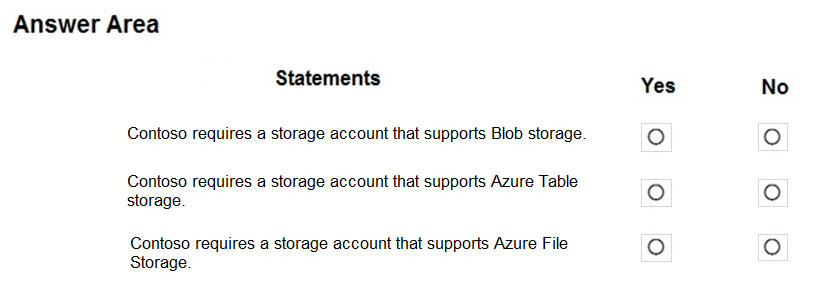

Contoso is moving the existing product blueprint files to Azure Blob storage.
Use unmanaged standard storage for the hard disks of the virtual machines. We use Page Blobs for these.
Box 2: No -
Box 3: No
Introductory Info Case study -
This is a case study. Case studies are not timed separately. You can use as much exam time as you would like to complete each case. However, there may be additional case studies and sections on this exam. You must manage your time to ensure that you are able to complete all questions included on this exam in the time provided.
To answer the questions included in a case study, you will need to reference information that is provided in the case study. Case studies might contain exhibits and other resources that provide more information about the scenario that is described in the case study. Each question is independent of the other questions in this case study.
At the end of this case study, a review screen will appear. This screen allows you to review your answers and to make changes before you move to the next section of the exam. After you begin a new section, you cannot return to this section.
To start the case study -
To display the first question in this case study, click the Next button. Use the buttons in the left pane to explore the content of the case study before you answer the questions. Clicking these buttons displays information such as business requirements, existing environment, and problem statements. If the case study has an All Information tab, note that the information displayed is identical to the information displayed on the subsequent tabs. When you are ready to answer a question, click the Question button to return to the question.
Overview -
General Overview -
Contoso, Ltd. is a consulting company that has a main office in Montreal and branch offices in Seattle and New York.
Environment -
Existing Environment -
Contoso has an Azure subscription named Sub1 that is linked to an Azure Active Directory (Azure AD) tenant. The network contains an on-premises Active
Directory domain that syncs to the Azure AD tenant.
The Azure AD tenant contains the users shown in the following table.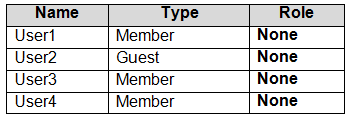
Sub1 contains two resource groups named RG1 and RG2 and the virtual networks shown in the following table.
User1 manages the resources in RG1. User4 manages the resources in RG2.
Sub1 contains virtual machines that run Windows Server 2019 as shown in the following table
No network security groups (NSGs) are associated to the network interfaces or the subnets.
Sub1 contains the storage accounts shown in the following table.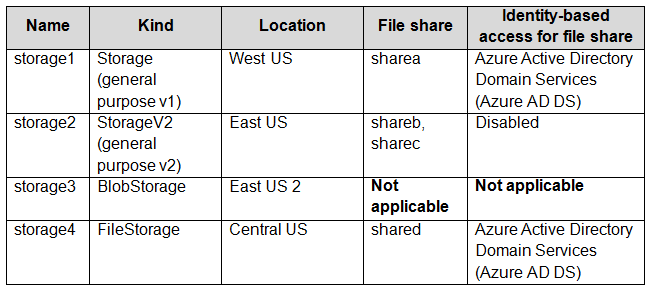
Requirements -
Planned Changes -
Contoso plans to implement the following changes:
Create a blob container named container1 and a file share named share1 that will use the Cool storage tier.
Create a storage account named storage5 and configure storage replication for the Blob service.
Create an NSG named NSG1 that will have the custom inbound security rules shown in the following table.
Associate NSG1 to the network interface of VM1.
Create an NSG named NSG2 that will have the custom outbound security rules shown in the following table.

Associate NSG2 to VNET1/Subnet2.
Technical Requirements -
Contoso must meet the following technical requirements:
Create container1 and share1.
Use the principle of least privilege.
Create an Azure AD security group named Group4.
Back up the Azure file shares and virtual machines by using Azure Backup.
Trigger an alert if VM1 or VM2 has less than 20 GB of free space on volume C.
Enable User1 to create Azure policy definitions and User2 to assign Azure policies to RG1.
Create an internal Basic Azure Load Balancer named LB1 and connect the load balancer to VNET1/Subnet1
Enable flow logging for IP traffic from VM5 and retain the flow logs for a period of eight months.
Whenever possible, grant Group4 Azure role-based access control (Azure RBAC) read-only permissions to the Azure file shares. Question HOTSPOT -
You need to create container1 and share1.
Which storage accounts should you use for each resource? To answer, select the appropriate options in the answer area.
NOTE: Each correct selection is worth one point.
Hot Area:
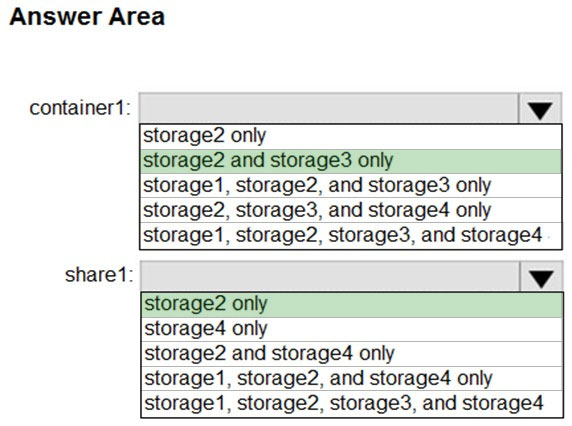
https://docs.microsoft.com/en-us/azure/storage/blobs/storage-blob-storage-tiers https://docs.microsoft.com/en-us/azure/storage/common/storage-account-overview
Introductory Info Case study -
This is a case study. Case studies are not timed separately. You can use as much exam time as you would like to complete each case. However, there may be additional case studies and sections on this exam. You must manage your time to ensure that you are able to complete all questions included on this exam in the time provided.
To answer the questions included in a case study, you will need to reference information that is provided in the case study. Case studies might contain exhibits and other resources that provide more information about the scenario that is described in the case study. Each question is independent of the other questions in this case study.
At the end of this case study, a review screen will appear. This screen allows you to review your answers and to make changes before you move to the next section of the exam. After you begin a new section, you cannot return to this section.
To start the case study -
To display the first question in this case study, click the Next button. Use the buttons in the left pane to explore the content of the case study before you answer the questions. Clicking these buttons displays information such as business requirements, existing environment, and problem statements. If the case study has an All Information tab, note that the information displayed is identical to the information displayed on the subsequent tabs. When you are ready to answer a question, click the Question button to return to the question.
Overview -
General Overview -
Contoso, Ltd. is a consulting company that has a main office in Montreal and branch offices in Seattle and New York.
Environment -
Existing Environment -
Contoso has an Azure subscription named Sub1 that is linked to an Azure Active Directory (Azure AD) tenant. The network contains an on-premises Active
Directory domain that syncs to the Azure AD tenant.
The Azure AD tenant contains the users shown in the following table.
Sub1 contains two resource groups named RG1 and RG2 and the virtual networks shown in the following table.
User1 manages the resources in RG1. User4 manages the resources in RG2.
Sub1 contains virtual machines that run Windows Server 2019 as shown in the following table
No network security groups (NSGs) are associated to the network interfaces or the subnets.
Sub1 contains the storage accounts shown in the following table.
Requirements -
Planned Changes -
Contoso plans to implement the following changes:
Create a blob container named container1 and a file share named share1 that will use the Cool storage tier.
Create a storage account named storage5 and configure storage replication for the Blob service.
Create an NSG named NSG1 that will have the custom inbound security rules shown in the following table.
Associate NSG1 to the network interface of VM1.
Create an NSG named NSG2 that will have the custom outbound security rules shown in the following table.

Associate NSG2 to VNET1/Subnet2.
Technical Requirements -
Contoso must meet the following technical requirements:
Create container1 and share1.
Use the principle of least privilege.
Create an Azure AD security group named Group4.
Back up the Azure file shares and virtual machines by using Azure Backup.
Trigger an alert if VM1 or VM2 has less than 20 GB of free space on volume C.
Enable User1 to create Azure policy definitions and User2 to assign Azure policies to RG1.
Create an internal Basic Azure Load Balancer named LB1 and connect the load balancer to VNET1/Subnet1
Enable flow logging for IP traffic from VM5 and retain the flow logs for a period of eight months.
Whenever possible, grant Group4 Azure role-based access control (Azure RBAC) read-only permissions to the Azure file shares. Question HOTSPOT -
You need to create storage5. The solution must support the planned changes.
Which type of storage account should you use, and which account should you configure as the destination storage account? To answer, select the appropriate options in the answer area.
NOTE: Each correct selection is worth one point.
Hot Area: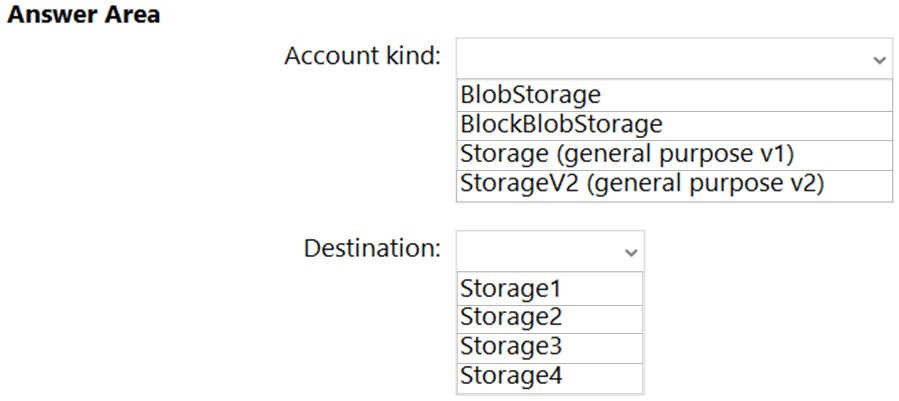
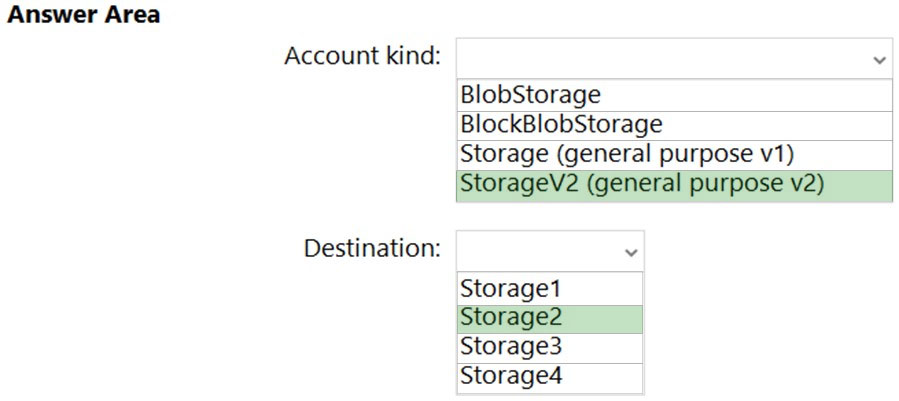
https://docs.microsoft.com/en-us/azure/storage/blobs/object-replication-configure?tabs=portal
- « Previous
- Next »
Viewing page 119 out of 122 pages.
Viewing questions 591-595 out of 606 questions
Dump định dạng mới giả lập EXAM + PDF
0.00
Chưa có đánh giá nào cho sản phẩm này.





Tài liệu
Tài liệu